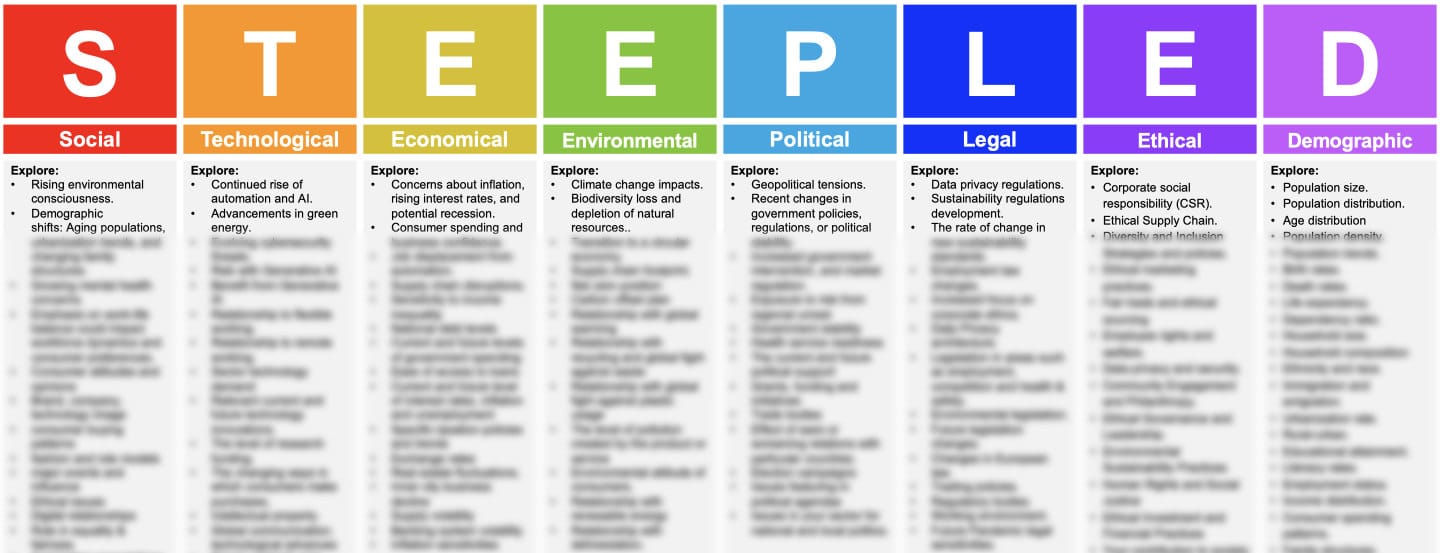
STEEPLED offers a structured approach to assess the myriad external factors influencing an organisation’s trajectory. We have a long history of providing Cheat Sheets for many business processes, and today, we’re excited to introduce a powerful resource to aid in mastering the intricacies of STEEPLED analysis: the updated STEEPLED Analysis Cheat Sheet and Workshop PowerPoint from Business-Docs.co.uk. This invaluable tool equips businesses and professionals with the means to conduct thorough analyses, identify emerging trends, and anticipate potential disruptions.
STEEPLED as a Robust Framework
At the forefront of strategic planning, STEEPLED analysis is a robust framework designed to systematically evaluate the Socio-cultural, Technological, Economic, Environmental, Political, Legal, Ethical, and Demographic factors impacting a business or industry. It provides a comprehensive lens through which to examine the broader context in which an organization operates, enabling informed decision-making and proactive strategy development.
What’s so great about STEEPLED?
So, what sets STEEPLED analysis apart, and why should businesses integrate it into their strategic toolkit?
1. Holistic Understanding: Unlike traditional analyses that may focus solely on market trends or internal capabilities, STEEPLED analysis takes a holistic view of the external environment. By considering a broad spectrum of factors, organizations gain a more nuanced understanding of the forces shaping their industry and market dynamics.
2. Anticipating Change: In today’s rapidly evolving landscape, change is the only constant. STEEPLED analysis empowers organizations to anticipate and adapt to emerging trends, technological advancements, regulatory shifts, and societal changes before they disrupt business operations.
3. Risk Mitigation: By identifying potential threats and opportunities across various dimensions, STEEPLED analysis enables proactive risk mitigation strategies. Whether it’s navigating regulatory challenges or capitalising on shifting consumer preferences, businesses can position themselves more effectively in the face of uncertainty.
4. Strategic Decision-Making: Armed with insights from STEEPLED analysis, decision-makers can make more informed strategic choices. Whether entering new markets, launching products, or allocating resources, understanding the external landscape enhances the likelihood of success and minimises the risk of unforeseen obstacles.
5. Enhanced Innovation: A deep understanding of external factors can inspire innovation and creativity within organisations. By recognizing emerging technological trends, societal preferences, and regulatory shifts, businesses can identify new opportunities for product development, service offerings, and business models.
6. Stakeholder Engagement: STEEPLED analysis facilitates meaningful engagement with stakeholders by addressing a wide range of concerns and interests. Whether it’s addressing environmental sustainability, societal impact, or ethical considerations, organizations can demonstrate their commitment to responsible business practices.
STEEPLED Analysis Cheat Sheet PPT – Updated for 2024
STEEPLED Analysis PPT – Cheat Sheet Updated for 2024
This STEEPLED Analysis PPT with Cheat Sheet enables you to brainstorm and workshop all aspects of your product or service, in your exact market setting. The cheat sheets enable you to prompt your teams’ thinking in each STEEPLED factor area so that you can maximise your chances of successful market fit.
STEEPLED analysis is not just a tool; it’s a strategic imperative for navigating today’s complex and interconnected business environment. By embracing this framework and leveraging resources like the STEEPLED Analysis Cheat Sheet and Workshop PowerPoint, organisations can unlock invaluable insights, seize opportunities, and chart a course for sustainable growth and success.